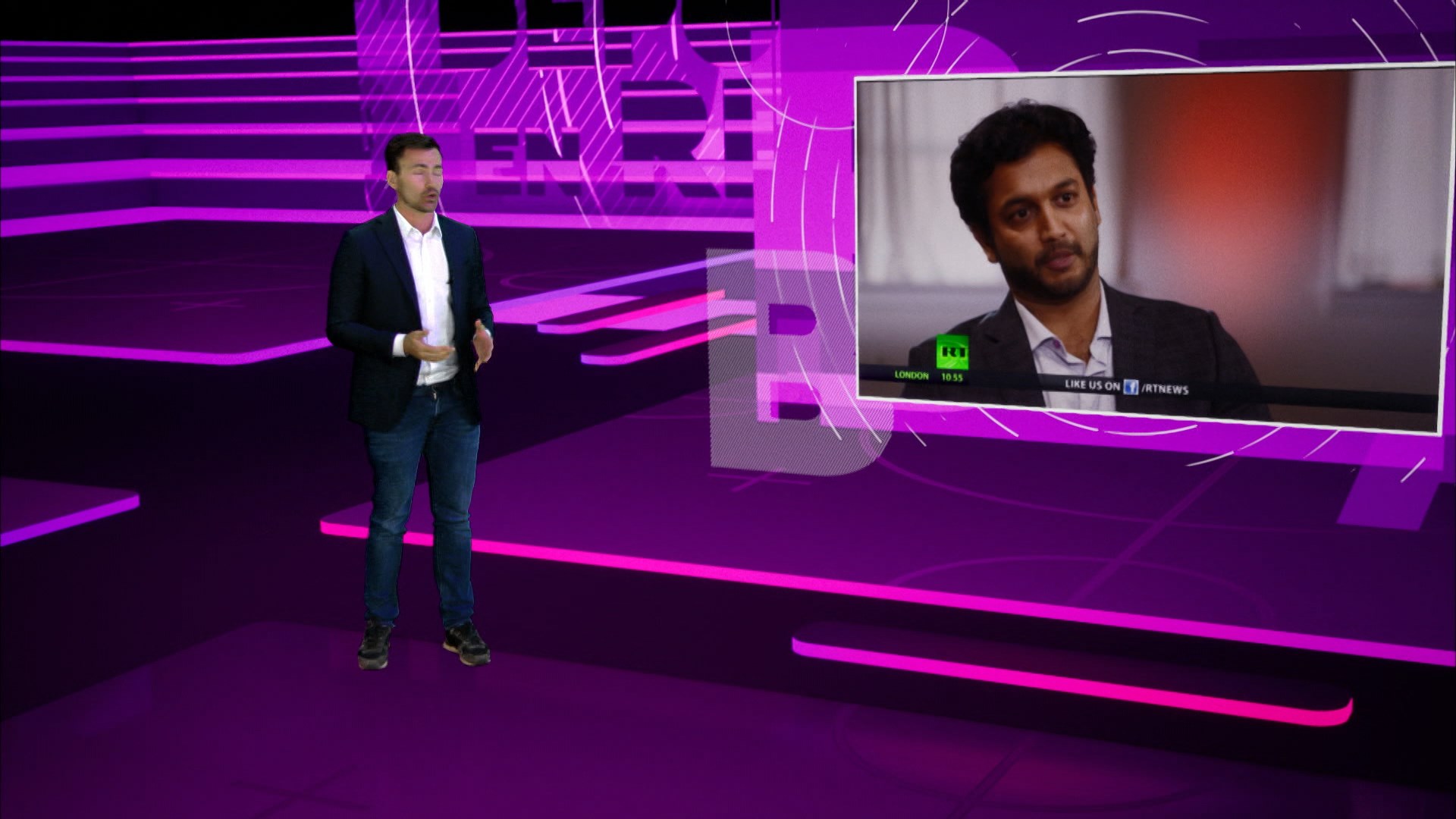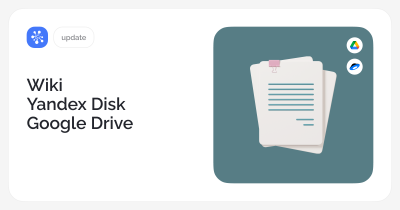In our interview, Andrew Amelin, RT’s head of the 3D graphics and special effects department, shares his story about using Cerebro. We’ve discussed how to create and enable fast post-processing of video and graphics for broadcast.

Please tell us about your creative path and how you ended up on Russia Today and in the industry in general. How did you get started in graphics and design?
How did I get into the industry? Let’s start with this part, because it was much earlier than my work on Russia Today. I got there in 1990, when I just returned from the army. Then I was positively struck by one TV advertisement, where a ballot was falling on the table. It was CGI, and the table broke off after the ballot landed. In 1990! I was awestruck and so I chose where to go to study. I entered the Moscow Engineering Physics Institute to study part-time at the Cybernetics Department, because I hoped they would also teach me the basics of computer graphics.
Naturally, no one there taught anything except programming, and I started working while studying. Actually, hold on, at first I signed my first contract with a company named “G Company,” with Loshkarev. When the contract expired, I went to work for the Rossiyskiye Universitety (Russian Universities) TV channel, while looking to graduate from my institute. I worked there for some time, and as I recall, we started using i386 computers with 3D Studio, the very first versions. We also used the Paintbrush software and it was perfectly normal. It wasn’t until later that Silicon Graphics software and the likes were introduced.
In fact, this entire industry started with the concept of computer graphics. It is now bursting with all sorts of terms, such as “post-processing,” for example. Back then, it was nothing like that; there was just pure computer graphics, which, among other things, was recorded frame by frame, so electronic montage was out of the question.
In the early 90s, the Japanese came to visit our channel, and Shabolovka turned out to be something like a museum of their own equipment, which had been out of use for 30-40 years in Japan.
During my time with Rossiyskiye Universitety, I had a side job related to visualization of architectural projects for several years. I collaborated with architects, who were equally inexperienced in this field as me back then. Then I went to Channel One, where I worked on the design, that is, on the broadcast graphics of the Vremya program. This was the time when Dorenko was thrashing Luzhkov, when the Ostankino tower was burning. On one of the shifts, we all wondered whether it would fall on us or not, because it really was tilting dangerously.

Then I worked for several years with architects, doing visualization and computer graphics. After that I went to the Rossiya TV channel (VGTRK), where I stayed until 2005, and afterwards I actually ended up on Russia Today. By the way, Russia Today has recently celebrated its 15th anniversary, and I can say that I’ve been working there virtually since the founding of the channel, all these years. I remember clear as a day how we were launching this whole establishment. Of course, there were many young people, but we worked at the Park Kultury station, in the building of RIA Novosti. I recall very clearly that there were a lot of foreigners running barefoot in tracksuits along the corridors to deliver urgent news on time.
Now that I’m the head of the 3D graphics and special effects department, and the workflow is much calmer, because everything settled down long time ago.
When did you start using Cerebro in your work?
About 3-4 years ago, when I was still the head of the 360-degree video department, where we were shooting 360-degree VR content, then adding 3D graphics and post-processing. Of course, then Cerebro helped organize the work very well. Since my department was just getting started, we were keeping track of everything in Excel files. It was deeply inconvenient. I also had to take notes on magnetic boards, scraps of paper, etc., and Cerebro was basically a salvation. It immediately shaped up a certain structure, which made it possible to create several threads and tasks at once. This tree network helped me understand who is doing what, at what stage it is happening, and how to control the process. It was easy to keep track of things like merging videos, i.e. the so-called stitching. Or take keying, i.e. the active phase, where we film the content against a green screen and overlay some effects in a virtual studio. Naturally, all this was very useful.
You told us about the time when the tower was burning, but was there anything exciting in the production? You have been on one TV channel for 15 years; this is a rather long career. There must have been something in the production process that comes to mind.
Of course, there have always been many interesting cases. For example, Channel One and the Vremya program in the period when it was hosted by Dorenko, may his soul rest in peace, and when Luzhkov was the mayor of Moscow. They had their own subscribers. As for computer graphics and broadcast design of films, we used such incredible capacities at such incredible speed that sometimes people would quarrel. The graphics were ready, but not everyone agreed with it. And this drive, this dynamic, this impossible forge of on-the-fly work in itself were worth a lot and gave me a lot of skills for my future. This was an amazing school.
Though as for Channel One, they still owe me eight months’ worth of salary. Well, holdbacks were very common at the time.
If we are talking about computer graphics less theoretically, I would divide it into the creative and the technical part. Because, naturally, there are creative people who can generate and come up with ideas, and there are also technical people who can implement all this. Sometimes these qualities are combined in one person, but in fact, such professionals are quite rare. I’ve seen different people—the creative ones that are hopeless in technology, or vice versa: those who are very tech-savvy, but have zero ideas of their own.
We need to find a combination of these qualities; therefore, overall, computer graphics is still team work. You can never say that one person does everything. Yes, it happens sometimes, but as a rule, the result looks less than great, so to speak. When a team works, going through all stages of creating computer graphics, from modeling and animation to post-processing and editing, we can make something really good. For example, when I ran a 360-degree video department at Russia Today, we had a lot of huge projects at the same time. One of them was filming in space on the International Space Station. Our guys had an agreement with Roscosmos, and our cameras were at the station. It was, of course, very unusual. Now our work is on display in some American museum.
When you combine graphics and video, you indeed get a riveting project. For example, we made a panoramic shot of the place where the Crimean Bridge will be built, and then combined video and graphics and visualized a bridge that did not exist yet. This, of course, was massively exciting, but unfortunately, the whole VR and 360-degree video thing did not end up in mass production due to the specifics of viewership. The main consumers of all our products are women, and women say, “This headset is uncomfortable, unhygienic, and ruins your hair.”
Thus, we stopped developing this area, which is a pity, because we did our best. There are special domed showrooms for viewing panoramic videos; we even built one for our channel. But the problem is that you can only see the upper hemisphere and what is below, and you cannot lower your head. When you put on a headset or VR goggles, you can look up, down, and generally in any direction.
This technology is not yet perfected. It is implemented in the PlayStation, VR games, but this is not exactly convenient. This VR thing is amazing, but, then again, it is held up by its inconvenience of use, because now you can’t just take a headset out of your pocket, put it on and plunge into some other world. Only when VR glasses become the size of regular glasses will our wonderful women finally say, “Yes, we accept it,” and this whole story may continue. And yet, even now we can say that there are some highly specialized areas, where technology is really developing.
Even broadcasts would be interesting, for example, when we put a VR camera in a ballet studio or in a concert hall during a performance, but again, all this is not tailored for the end user. It is either too expensive or too inconvenient.
By the way, when I look back, I think Cerebro would definitely come in handy in the studio for visualization of architectural projects. They probably use it at this point, but at the time when I worked there, it would be a real salvation, because it would make building a workflow so much more convenient.
If we are talking about computer graphics applied to architectural projects, then it clearly is nothing but routine. That is, we do not need creative types, but rather the techies. Creative types are more about motion design. It is a trendy name for what is, in fact, regular animated computer graphics.
Thank you very much for sharing. You mentioned that there are the techies and the creative types, and it is hard to find someone who would combine all in one person. Please tell us, which type do you consider yourself to be? Or do you combine both?
I’m probably more of a techie after all. Of course, I can come up with something interesting, but I understand that there are more creative idea generators out there, and there is really few of them. By the way, we are still looking for such professionals, because creative types, sadly, are very prone to burnout. They fall out of trend, run dry and become simply unable to come up with something new.
I mean, techies keep afloat, because they know their tools and stay in the trend of technical solutions, but creative types—real creative types—burn out very quickly, and this, naturally, is our scourge. It is very difficult to constantly generate something of your own without looking anywhere. Just sitting down and creating is very difficult. To do this, you need to be born an incredibly talented person. I do not consider myself to be such, I am still a techie.
By the way, I would like to take this opportunity to invite creative people who have their own ideas and some underway projects to collaborate. We are waiting for you on Russia Today; we are always happy to talk and, I would like to think, we provide good working conditions, so I’d like to extend an invitation here and now.

We actually can publish your invitation. We have a second project named Staya. Companies use it to look for creative employees, so we will be happy to help you in the selection process. As for the places of search… So you say that you are trying to catch creative people, but where to find them? What kind of places you know out there?
How do we look for creative people? You know, there is such a thing as word of mouth. Because coming across really worthy professionals by posting ads is extremely rare. Basically, there is a stream of random people who seem to be able to generate something, but either do not know how to work in a team, or do something wrong. It is very hard to find really decent and good people. This is a huge problem for everyone. We’ve even worked with some third-party designers, but sometimes they hand over something you just can’t look at without crying.
I’ll say it again: the ideas are a huge gift. It is either there or it is not. An insight comes very rarely and to very few, and, as a rule, these people are already in demand somewhere else. Surely there are worthy candidates among those seeking a job as well, but it is not easy to find them. You know, we have a lot of great professionals in our team, but I want to somehow find those who will have fresh ideas, fresh solutions. Many wannabe designers do not just peek somewhere and copy some details, but compile someone else’s work and pass off as their own. Unfortunately, plagiarism in this area is very common, and there are really very few pure ideas, so if some people really want to try themselves in motion design, let them come to us, we are always waiting for them, we can appreciate them.
The Steal Like an Artist book comes to mind; it is a set of recommendations for people who really like to copy and paste. You are right, this is very common. Also tell us, please, how many people do you currently have in the department? How big is your team?
I run a somewhat small department. I have eight people under my command. The design department is bigger; there are over 100 people together with the broadcast graphics department, i.e. this is all the creative staff. Our team is huge and very structurally ramified. In the design department, we have already introduced Cerebro, which allows us to structure the workflow and track all stages. I find this software very interesting. I only have one wish.
I bought myself a tablet to work from home, installed Cerebro and ran into a problem that upset me a lot. When I use the mobile version on the tablet, it is very limited, like on the phone; I cannot even change the status of the task. I would like to see everything on a tablet exactly as I see it on a computer, like a branched structure. Not something squeezed down to a few buttons, but an entire system tree, so that I could see the process and manage it directly from the tablet. As it is, you still have to use a desktop computer to keep track of everything, because the truncated mobile version clearly lacks the capabilities available on a desktop computer. It would be great if you at least adapted the desktop version to tablets, so that you could run the processes using a stylus on the big screen. It feels a little weird to use a tiny mobile version on a large tablet.
Yes, we should do it, and it’s already in the plans. We have heard about this and really want to come up with a full-fledged version in the future. Thank you very much for this feedback, because it is really important. Now let us get back to the questions about your team. What daily tasks does it face and how does Cerebro help solve them and manage projects? How do you like this system at work?
We use Cerebro to enable fast post-processing of video, graphics, and everything else. With the help of Mirada, we see some fragments, places that can be corrected. It also helps in structuring the tasks on 3D graphics. Now we are actively using the Unreal shell. It is meant for gamers, but we use it to design live broadcast.
To put it all together, you need to go through several stages. First, there are three-dimensional scenes, filling with three-dimensional objects, then optimization, live broadcast, and then overlaying. These technologies that are not so much related to Cerebro as to computer graphics in general.
Are there any functions that you, so to speak, ignore in Cerebro? Something you’ve never grown to use, but know that it exists. Are there any?
Well, there is a Gantt chart; it makes no sense for me to use it, because TV probably relates more to payroll policy, while the chart is mostly for private companies with hourly pay and such.
Then again, it has everything to do with two types of contractors. Some are creative types, others are techies. They need to have very different wage policies. Cerebro is obviously more tailored for techies, not for creative types. It is very useful for routine work: stitching, post-processing, and so on.
You are probably, like any other person, looking for sources of motivation and inspiration for yourself. For example, you did tell us about the space projects. Are you looking for sources of inspiration as a leader? And another question: how do you try to motivate your employees, and do they need motivation at all in your case?
As for personal inspiration, I draw it from music. Do you know the song that goes like, “there is only harmony in music”? If you put on headphones and turn on some music, you can usually imagine some visuals, which can be embodied in some projects. Again, this is purely how I see it, exclusively my experience and my impressions. That is, my inspiration comes through music. How do I inspire my employees? Well, I simply state a problem, then explain the idea, and since this is team work, then the result should follow. Exactly the result. As a leader, I use either a stick or a carrot. Either a reprimand or a bonus.
So you have a classic structural approach. This is encouraging, because some users find it difficult to get employees to report in the project management system. As far as I understand, you have no problems with this?
My time in the army probably helped me to some extent. As they say, a good general comes from a good soldier. A person who does not know how to obey does not know how to lead. This is an axiom that has been repeatedly confirmed both in life and in practice, therefore, in terms of leadership, everything works just fine. Cerebro helps state the problem very clearly and then demand the result. Because if funds, time, resources are allocated, then sooner or later the time will definitely come to see the result. These are managerial aspects, let’s call them, and I believe that there should be a clear top-down chain of command. Unfortunately, there is no way without it.
We’ve had a lot of conflicts, and people left us after situations when an overly creative person first prepares to get into the full swing for several days, then works hard for a day or two, and then goes to bed and gives a completely unbearable result. This is exactly the flip side of very creative individuals, although they are wonderful people. Sometimes you have to part with them, and it is very hard every time. After all, no matter how a person works at a given moment, they still have moments of insight when they give out worthwhile ideas, excellent visualization, and brilliant results.
The symbiosis of a creative type and a techie helps a lot when they work in pairs, in a team. You can bring them together, but do consider that it is very difficult to control a creative person there, because, excuse me, there will still be a lot of sloppiness.

Now you’ve just shared the secret of success, how to combine it all. This means that under your leadership, Cerebro probably quickly caught on. Were there any difficulties at the implementation stage, when you just started using Cerebro in the company?
I just had to go directly to each employee and explain everything. And thank you, you helped a lot with video conferencing and communication, explained online what to do and how, which buttons to press to get something done.
It is always exciting to learn new things, but it takes some time. And when people have already been taught and accustomed to using the system, then no problems arise. Now, for example, it is no longer difficult to explain to new people where to click as a user, what to read and how to draw up reports. In general, I do not see any big difficulties associated with getting people to use Cerebro. The interface is quite user-friendly and much simpler than any 3D graphics software, where everything is clearly more complicated by several orders of magnitude. Those that work with computer graphics will have no problems with mastering Cerebro. It is, you know, as if you’ve been riding a racing bike and then suddenly someone asked you to ride a tricycle. It will obviously go smoothly! In this regard, everything is good, and you give out a very good product. May God grant you, as they say, further prosperity and development.
Thank you, Andrey, how very nice. In fact, our users are divided into two camps: those who want one button for everything and those who need more buttons. We have to somehow maneuver. Thank you very much for such a feedback.
If you have any more questions, I will be happy to answer.
Only if you have some “fly in the ointment” in mind and, perhaps, some other wishes. What would you like to see implemented in the system? What is lacking? What would you like us to add? We draw up a roadmap for the project, there are some plans, but we are developing and will be happy to add new functions; something new to make the software easier and more convenient to use.
The ability to link it with After Effects, Photoshop, 3Ds Max. At some point we asked for it, and it was implemented. There is only one wish, which I have already mentioned: to adapt the system to use on a tablet. It would be nice to have all those buttons from the desktop version on the tablet. The truncated mobile version gives me a brain freeze; why would you limit the already simple software? This is a mystery to me.


